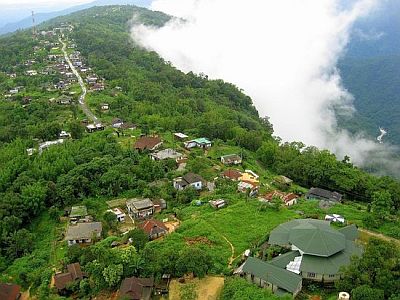Select units of measurement for the temperature and rainfall tables (metric or imperial).
Average weather, temperature, rainfall, sunshine hours

In Cherrapunji (or Cherrapunjee, also known as Sohra) we have a
subtropical mountain climate, with mild, dry winters, from December to February, and a long rainy period from March to October, during which exceptional amounts of rainfall are reached.
The town is located in the north-east of India, in the small state of Meghalaya, at 1,300 meters (4,200 feet) above sea level, and is famous for being the
rainiest inhabited place in the world.
The rains are due to the Indian monsoon, but are more abundant than elsewhere due to the geographical position. Cherrapunji is in fact located on a plateau within the
Khasi Hills, low mountains that are located north of Bangladesh and enhance the formation of rains and showers, in an area that receives warm, humid winds from the Gulf of Bengal, which are then forced to climb when encountering the mountains. The period of the day in which the rains are most frequent is the morning.

Since the area is extremely rainy, it is covered by forest, and there are also several streams and waterfalls. Furthermore, there are caves.
More than 11 meters (36 feet) of rain fall in a year. The rainiest months are June and July, with more than 2.5 meters (98 inches) per month.
According to some sources, there is an even rainier location,
Mawsynram, a village located nearby, 15 km (9 mi) to the west and at 1,450 meters (4,750 ft) above sea level, which receives 11,870 mm (almost 39 feet - 467 in) of rain per year.
To understand how local the phenomenon is, just think that in Shillong, the capital of the state of Meghalaya, located in the northern part of the plateau, rainfall amounts to "just" 2,200 mm (86.5 in) per year.
The actual
monsoon runs from early June to early October, however, from March to May, the rains and thunderstorms are increasingly more frequent and abundant, to the point that May is already an extremely rainy month, with almost 1,300 mm (51 in) of rain. Even in October, the last month of the monsoon, the total exceeds 450 mm (17.5 in). The months of December and January, however, are very dry.
Cherrapunji has entered the
Guinness Book of Records for receiving the maximum amount of rainfall in a year: 26,470 mm (nearly 26 and a half metres - almost 87 feet) from 8 August 1860 to 7 July 1861, of which 9,300 mm (30 feet and a half) in July 1861.
In more recent times, when measurements are more reliable, in 1974, 24,555 mm (80 ft and a half) fell, while the maximum rainfall in one day was 1,563 mm (61.5 in), on 16 June 1995.
In the precipitation table, days in which more than 2.5 mm (1 in) fall are counted as rainy days. Here is the average rainfall.
Cherrapunji - Average precipitation| Month | Days |
|---|
| January | 16 | 1 |
|---|
| February | 54 | 2 |
|---|
| March | 364 | 7 |
|---|
| April | 792 | 16 |
|---|
| May | 1297 | 21 |
|---|
| June | 2608 | 25 |
|---|
| July | 2665 | 28 |
|---|
| August | 1769 | 24 |
|---|
| September | 1090 | 18 |
|---|
| October | 461 | 8 |
|---|
| November | 49 | 2 |
|---|
| December | 10 | 1 |
|---|
| Year | 11175 | 154 |
|---|
The
winter, from December to February, is mild, however, sometimes it can get cold at night, so much so that the temperature can drop to 3/4 °C (37/39 °F). The record is -1 °C (30 °F), set way back in January 1913. Already in February, the rains begin to become a little more frequent.
In
summer, or rather in the monsoon period, the daily average exceeds 20 °C (68 °F) from June to September, however, the rains occur almost daily, and are often torrential.
Since it rains often and the sun rarely shines, it gets rarely hot. On the warmest days, temperatures generally reach 27/28 °C (81/82 °F). The record is 31 °C (88 °F), set in September 1969. Here are the average temperatures.
Cherrapunji - Average temperatures (1991-2020) |
| Month | Min | Max | Mean |
|---|
| January | 6.6 | 17.2 | 11.9 |
|---|
| February | 8.7 | 18.8 | 13.8 |
|---|
| March | 12.1 | 21.4 | 16.8 |
|---|
| April | 14.4 | 22.7 | 18.6 |
|---|
| May | 16.1 | 23.1 | 19.6 |
|---|
| June | 17.7 | 23.1 | 20.4 |
|---|
| July | 18.1 | 22.9 | 20.5 |
|---|
| August | 18.2 | 23.6 | 20.9 |
|---|
| September | 17.6 | 23.9 | 20.8 |
|---|
| October | 15.3 | 24 | 19.6 |
|---|
| November | 11.4 | 21.8 | 16.6 |
|---|
| December | 8.2 | 18.8 | 13.5 |
|---|
| Year | 13.7 | 21.8 | 17.7 |
|---|
Occasionally, Cherrapunji may be affected by
tropical cyclones coming from the Bay of Bengal. Compared to the coast of Bangladesh, where they discharge most of their energy, they arrive weakened, however, when they encounter the mountains, they can bring heavy rainfall.
Cyclones generally occur from mid-April to early December, with a greater probability before and after the monsoon, i.e. in May-June, and October-November.
Best Time
The
best time to visit Cherrapunji is the dry season, from November to February. November, an autumn month, is milder, and it gets cold at night with more difficulty, however, the driest months are December and January.